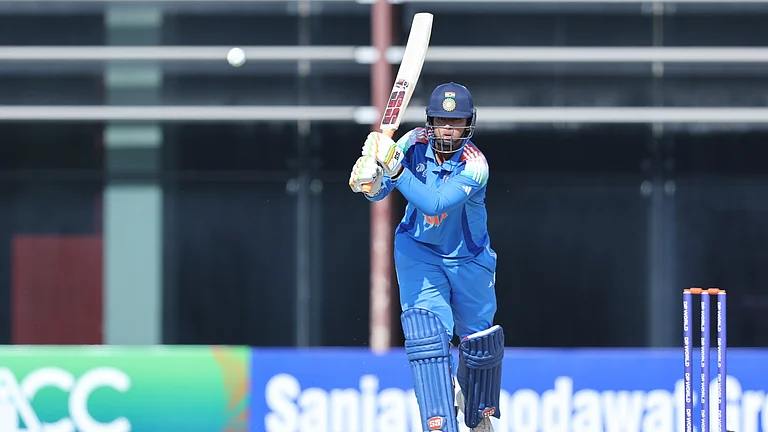A: When we were solicited for this contribution, Outlook told us they wanted ‘two voices’ from Kashmir for its 21st anniversary issue. On being asked, they confirmed the other contributor was (indeed) going to be a Kashmiri Pandit (KP), because they had asked the one with a Kashmiri Muslim (KM) name among us.
This KP-KM dialectic in every conversation on Kashmir in India is fascinating, but reveals more about India than it does about Kashmir. There are many planes on which a conversation on the future and past of J&K can happen, many angles from which its various issues can be tackled. Why not a conversation between a Tibetan Buddhist in Zanskar and a Pahari-speaking Muslim of Rajouri, or a communist Dalit from Kathua and a Shia from Kargil, or between a doctor at Mirpur in Azad Kashmir and a paddy farmer in Islamabad (Anantnag) in Indian-administered J&K? If it is about numbers (or as a majority of Indians, having never read Ambedkar, call them: democracy) Kashmiri and Pahari Muslims constitute the two largest ethnic groups in undivided J&K, making up more than two-thirds of its population. Why does a conversation between them not capture the imagination of Indian audiences the way the KM-KP conversation does?
A: Why not the gender debate, since men and women together easily constitute more than 90 per cent of J&K’s population? Is it because Indian audiences realise that the migration of KPs from the Valley to other parts of J&K and India in the early 1990s is a baton with which they can beat the pro-freedom constituency shamelessly? Or is it because persecution of Brahmins is a cardinal sin in a Brahminical empire disguised as a secular, socialist republic?
A: The near-total ignorance of Indian columnists and intellectuals on Kashmir (not to talk of the great Indian middle class) is baffling. In report after report from the ‘ground’, they keep reciting the same old mantras—‘economic packages’, ‘sadbhavana missions’ etc. How many Indians know that the slogan ‘Kashmir for Kashmiris’ first came from Kashmiri Pandits and not Muslims? How many know that Prem Nath Bazaz, a Kashmiri Pandit, was among the chief architects of the idea of ‘Azad Kashmir’? How many know that militant ranks, even pro-Pakistan Islamist groups like Hizbul Mujahideen, have had Hindu guerrillas right from the mid-1990s. Subhas Kumar Shan was a deputy divisional commander of Hizbul from Kishtwar. This ignorance of India’s ‘Kashmir experts’ is not natural or inevitable, but rather a deliberate obliteration of facts and obfuscation of the multiple realities of J&K to forward the agenda of their Brahminical empire.
A: Worse than this informed ignorance are their questions. They ask, “What do you mean by azadi? ... Azadi is such a vague concept, it means different things to different people, doesn’t it?” Notice that when it comes to denying us our rights, they suddenly remember the differences between us, but when it suits their agenda, say the elections India conducts in Kashmir, or recruitment drives for India’s armed forces and civil services, or the state police service, all participants are considered to be unanimously voting for India. Can’t it be because some just want a job, or don’t think being a civil servant and wanting azadi for Kashmir are contradictory positions, or even want to join the armed forces “to take revenge for the killings in Kashmir”?
A: As Angana Chatterji put it: “‘Freedom’ represents many things across rural and urban spaces in Indian-ruled Kashmir. These divergent meanings are steadfastly united in that freedom always signifies an end to India’s authoritarian governance.” And when the ‘experts’ realise these questions can no longer confuse or stall us, they ask about our vision for Kashmir’s future, implying, one, we don’t have a programme for the future as we are like dogs chasing the azadi car and wouldn’t know what to do if we caught it, and, two, even if we have something we call a vision for Kashmir, we must submit it for their approval so they can check its viability and make necessary improvements.
A: Obviously, they don’t bother to read the ‘Naya Kashmir’ document, a revolutionary constitution written for a free J&K before India and Pakistan were born. Instead, India’s intellectuals and middle classes make a lot of noise about Shariah, as if it’s code for pariah. Shariah is no monolith; it has been practised from Morocco to Indonesia and from Kazakhstan to Zimbabwe for more than 1,000 years. Just like all other great legal traditions, it has not kept pace with the rapidly changing world, but like them all, its basic markers too are justice, truth, equality and peace, which can be used to improve it in a globalised paradigm. Even the Indian Constitution doesn’t guarantee non-citizens equality before the law and, similarly, the Shariah has different legal standards for Muslims and non-Muslims.
A: It is also a little rich for Indians to use the spectre of the imposition of Shariah in J&K as an excuse to continue holding it against the wishes of its people. India doesn’t have a great record of dealing with minorities, and things there are only getting worse. Countless people, lacking proper shelter, die from extremes of weather; thousands of indebted farmers commit suicide every year. And these aren’t aberrations in policy implementation, but, like the beef ban, are practices enabled and promoted by India’s Constitution and other laws.
A: In the early 1950s, the National Conference government (then a pro-plebiscite party) completely abolished landlordism in J&K, unleashing the poor peasantry from centuries of oppression. In the first year of land reforms, 92,297 hectares were transferred to 2,89,992 tenants, making for a ratio of 1.23 hectare per peasant. Again, in 1953-54, 36,619 hectares were distributed among 1,15,831 tenants. The number of students in primary schools went up four times—from 0.64 lakh students in 1950-51 to 2.94 lakh students in 1981-82. J&K made education free up to the university level. The health sector became the wealth sector, with expenditure by the J&K government increasing from Rs 28.1 lakh to Rs 128.81 lakh within a decade.
A: Moreover, sectors like transport and power generation progressed fast. Where the total road length was 1,209 km in 1955-56, it became 11,692 km in 1981-82. The number of electrified villages rose from 15 to 6,097 in roughly the same period. Although the agenda of connectivity changed from the 1960s, as did the energy politics of the region—both being reoriented to serve India’s national interest rather than the people of J&K—yet, in 1961-62, the per capita budget revenue of the J&K government was Rs 48, as against India’s national average of Rs 23.
A: Two things were happening side by side. One, the movement for dignity, equality and democracy that had started in J&K in the 1930s tried to implement as much of the ‘Naya Kashmir’ programme as it could despite the Indian occupation. But there is a limit to progress under slavery. Two, by 1960, the Indian State realised that a prosperous and educated J&K would be a threat to its control over the territory. By the mid-1960s, the scale of interference by the Indian leadership in J&K was cranked up massively. Within decades, the flourishing economy slumped, unemployment increased and J&K was made the battlefield for playing the ‘national political game’.
A: It should, in fact, have been the opposite. Romesh Chandra, a leftist intellectual and journalist who had attended the historic Sopore session of the National Conference, once wrote, “Sopore convinced me that the desire for unity—for self-determination and freedom—was now in the blood of Kashmiri men and women. They must now show to India that unity between major parties is not only possible, but the only way to freedom.”
A: Kashmir has always shown the way. Yet, instead of following it in the path to freedom, India has dragged Kashmir in the opposite direction, not realising that in doing so it is taking itself towards less and less freedom. But that makes things clear for us. The path to freedom, as well as prosperity, equality and dignity, is in the direction opposite to the one India is following.
A: You know, last summer a 10-year-old cousin of our friend, who occasionally pelts stones and has been asking me for a poster of slain Hizbul militant Subhas Kumar Shan, posed a very difficult question. He was about to beat to pulp a seven-year-old boy half his size and, when I stopped him, he wanted know why he should not do so. I went through the entire history of ethics to find an answer. In my most charming and child-friendly way, I gave him lessons in Dhamma, provided Dharmic reasons, presented Christian morality, used examples from Sunnah and Hadith, and ran through Socrates, Kant and Nietzsche, but could see from his face that he was not convinced. Finally, it struck me. I told him, simply, “Do you want to be India?”
He got up and hugged the other boy who had been sobbing fitfully up to that point.
(Amit Kumar is a doctoral student of history at Delhi University. Arif Ayaz Parrey is an editor and Kashmiri writer.)



















